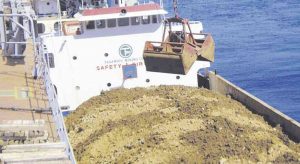MINING in northeastern Mindanao’s Caraga region has increased the local community’s vulnerability to the climate crisis, damaged livelihoods, and increased food insecurity, according to an international climate and human rights group.
In a news report released on Tuesday, Climate Rights International (CRI) warned of the industry’s impact as global demand grows for electric vehicle batteries, which use nickel as a key raw material.
“Nickel mining and related pollution have damaged the environment and threatened the rights of communities in multiple ways, including by destroying livelihoods, driving food insecurity, polluting water resources, threatening health, and impacting education,” CRI found.
BusinessWorld approached the Chamber of Mines of the Philippines for comment, but the chamber said it is still studying the report.
The Philippines is the world’s second-largest producer of nickel and the leading exporter of raw nickel ore. The United Nations trade database indicates that the Philippines exported nearly 45 million metric tons of nickel last year, valued at over $1.04 billion.
CRI’s report was the result of field research in mining-affected communities in the Caraga Region this year, including interviews with residents in Surigao del Sur and Dinagat Islands.
Caraga accounts for over half of the Philippines’ total metallic mineral output in terms by value, according to the Mines and Geosciences Bureau (MGB).
Twenty-six active mines operate in the region, including 23 specializing in nickel.
At a forum on Tuesday, CRI researcher and report author Krista Shennum said residents of mining communities have reported respiratory and skin problems, with their drinking water polluted by runoff.
CRI also found that fisherfolk in Dinagat Island and Surigao del Sur that fish stocks have been depleted due to mining activity, with farmers reporting that their rice fields have been left flooded and polluted, resulting in elevated food insecurity.
“Residents in Tubajon on Dinagat Island described how the loss of forests and mangroves due to mining operations and mining-related pollution makes their communities more exposed to storm surges, high winds, and flooding during extreme weather events like Super Typhoon Odette in 2021,” according to the report.
The researchers also reported instances of harassment, intimidation, and even killing of those opposed to mining activities.
According to a 2024 report by human rights group Global Witness, the Philippines remains Asia’s most dangerous country for environmental workers.
“Some individuals in the Caraga Region and across the Philippines who have challenged mining companies have faced lawsuits that they believe are intended to silence their activism,” the report found.
CRI quoted Tubajon, Dinagat Mayor Fely Pedrablanca as saying that mining companies have threatened to sue the local government over its opposition to mining activities and for publicly disclosing information about their tax payments.
With the shift toward clean energy, global demand for nickel is expected to rise in the coming decades. According to CRI, a scenario that assumes compliance with Paris Agreement goals produced an estimate of 60% nickel consumption growth by 2040.
Philippines nickel ore production rose 19.3% year on year by value, according to the MGB.
Most of the nickel mined in the Philippines is shipped overseas as raw ore of processing, with more than 90% of exports going to China. Exports to Indonesia also rose by more than 4,000% between 2023 and 2024 as Indonesian smelters faced shortages of nickel ore.
CRI is urging the government to freeze approvals for new nickel mines and review existing sites’ environmental compliance. — Vonn Andrei E. Villamiel

